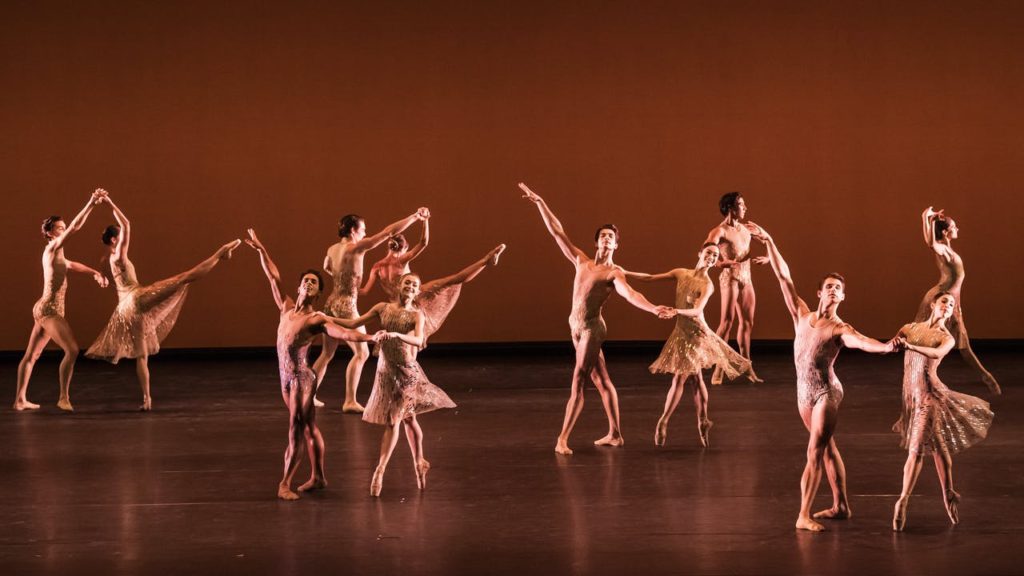VIEWPOINTS – Pre-“Nutcracker” dance roundup: A rejuvenated ABT, revisiting Batsheva’s YAG in movie form, and a treasure trove from the Royal Ballet
- By drediman
- November 27, 2020
- No Comments
Before dance companies start pivoting to “Nutctracker”-mode, I was able to continue streaming some fantastic virtual fall dance programming from a couple of major companies.

ABT TODAY: THE FUTURE STARTS NOW
American Ballet Theatre
As evidenced by American Ballet Theatre’s gala ABT Today: The Future Starts Now (RECOMMENDED), the beloved dance company is taking bold steps to reimagine itself into a more inclusive and open-minded institution. In terms of choreographers, dancers, and content, the four new works premiered during the virtual gala showcased remarkable diversity. The most striking case in point was Christopher Rudd’s passionate pas de deux Touché, which — in addition to boasting a Black choreographer and a Black principal dancer (the gorgeous Calvin Royal III) — also depicted an interracial gay relationship. That the work didn’t shy away from the erotic aspects of romance only made the dance bolder, and more compelling. Not as groundbreaking but still worthwhile were Gemma Bond’s somber Convivium and Darrell Grand Moultrie’s jazzy and infectious Indestructible Light; these were nicely contrasting works that respectively expressed dancers’ frustration over their current predicament, as well as their exuberant underlying love of their art. Although the three aforementioned ballets were filmed expertly, they were still very much evidently stage creations — which is not the case with the fourth world premiere. That would be Pam Tanowitz’s David, a solo dance-cum-film created specifically for David Hallberg, one of Ballet Theatre’s great stars. By transposing Mr. Hallberg with Michelangelo’s iconic David sculpture, Ms. Tanowitz has conjured a striking meditation on the opposing concepts of beauty and permanence. Its overt melding of dance and art film has resulted in a true hybrid that transcends both mediums. All-in-all, I applaud Ballet Theatre for so emphatically resetting its priorities to reflect current expectations. Happily, this new energy has has also rejuvenated the stakes and relevance of the company’s dance-making.

YAG: THE MOVIE
Batsheva Dance Company
Watching the Ohad Naharin episode of the Netflix documentary series Move recently whetted my appetite to see the singular Batsheva Dance Company (for which the influential Israeli choreographer acts as artistic director) perform once again. As if to answer my prayer, Batsheva last weekend streamed YAG: The Movie (RECOMMENDED) to its many fans around the globe, including yours truly. I’m happy to report that the viewing thoroughly satisfied my craving for the company’s unique brand of dance. Although I still missed the visceral excitement of watching the extraordinary Batsheva dancers perform in person, the film (which was shot this October) is a superb capture of the 1996 dance theater piece, which depicts an intergenerational, seemingly dysfunctional family and the bizarre relationships between its members. As with much of Naharin’s output, YAG is committed to authentically theatricalizing the human condition through uninhibited, uncontainable bursts of movement. In adapting the piece into a film, the choreographer takes the best elements of both live dance and cinema to create an experience that stands on its own. Experiencing the work through the camera’s gaze highlights its richly developed relationships more so than than I remember when watching it live. Additionally, the loosely suggestive narrative threads have heightened importance on film rather than the exhilarating cacophony that tends to steal the show during live performances of Naharin’s dances. In final assessment, YAG: The Movie is a fascinating lens through which to view the choreographer’s brilliance, although it can’t replace the gorgeous explosiveness of the in-person experience.

LIVE – WITHIN THE GOLDEN HOUR
The Royal Ballet
In this era of digital programming, it’s more common for dance companies to present compact bills that tease rather than fully satisfy. Leave it to the Royal Ballet to reverse this trend. Earlier this month, the renowned ballet company presented a jam-packed gala-like program (HIGHLY RECOMMENDED) consisting of a world premiere, a bevy of excerpts (mostly highlighting the company’s long affiliation with Frederick Ashton and Kenneth MacMillan), and a mesmerizing contemporary one-act ballet. The world premiere of Valentino Zucchetti’s Scherzo had the privilege of opening the two-hour-plus program. Featuring a small ensemble, it’s an elegant neoclassical ballet that got the evening off to a solid, promising start. What then followed was a procession of riches, as a number of the company’s stars took to the stage in a series of solo or pas de deux (mostly excerpts). Some highlights included Francesca Hayward’s highly anticipated and exquisitely nuanced foray into Swan Lake, Natalia Osipova’s daringly melodramatic take on The Dying Swan, and the statuesque William Bracewell’s perfect rendition of Ashton’s Dance of the Blessed Spirits. The marathon evening concluded with a performance of Christopher Wheeldon’s 2016 one-act ballet Within the Golden Hour. I hadn’t seen the ballet before, and in my initial estimation, it ranks among Wheeldon’s finest works to date (along with DGV: Danse à Grande Vitesse for City Ballet). Choreographed for eight dancers (four pairings) and set to a score by Ezio Bosso, Within the Golden Hour is a mature work that unfolds with unassuming confidence and effortless invention. As with the rest of this treasure trove of a program, the Royal Ballet dancers performed the piece with shimmering refinement and grace.

 Copyright © 2024
Copyright © 2024
Leave a Reply